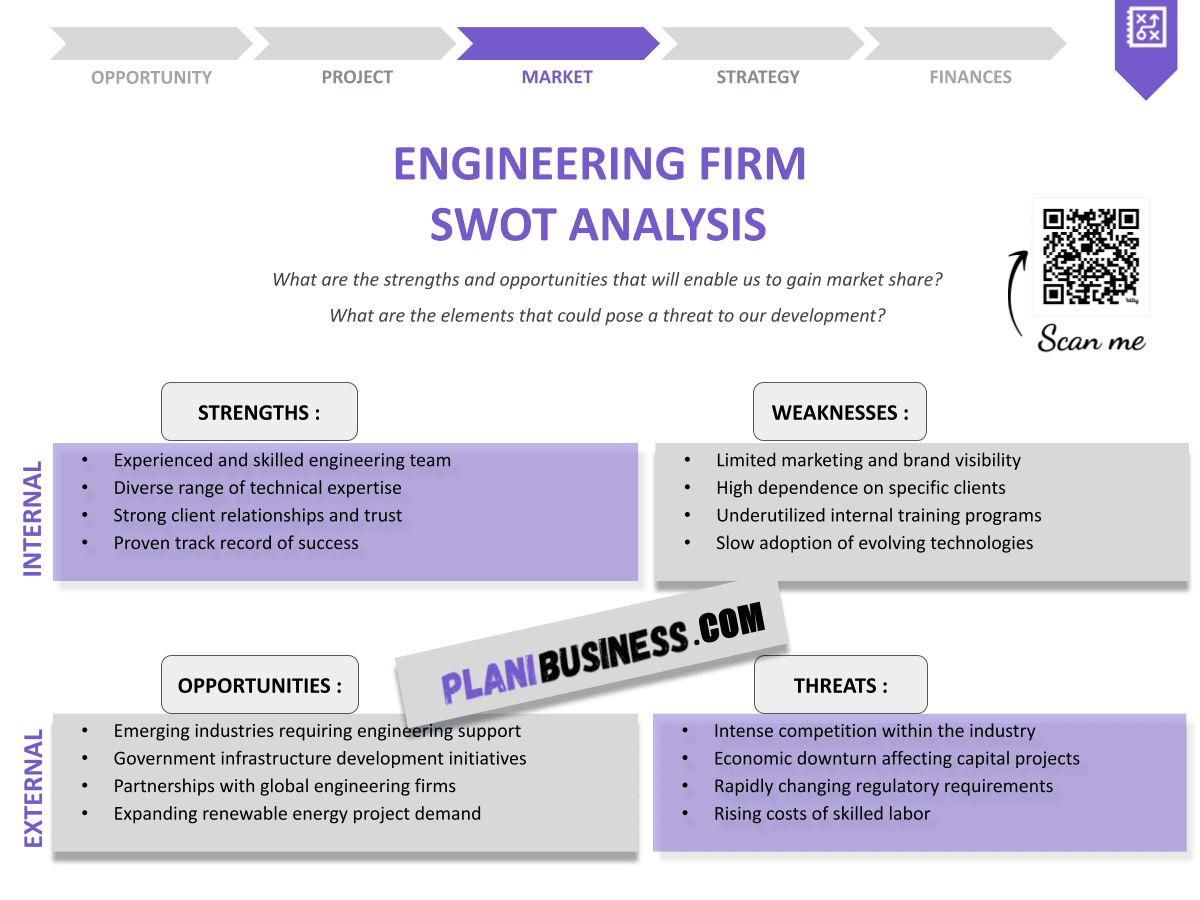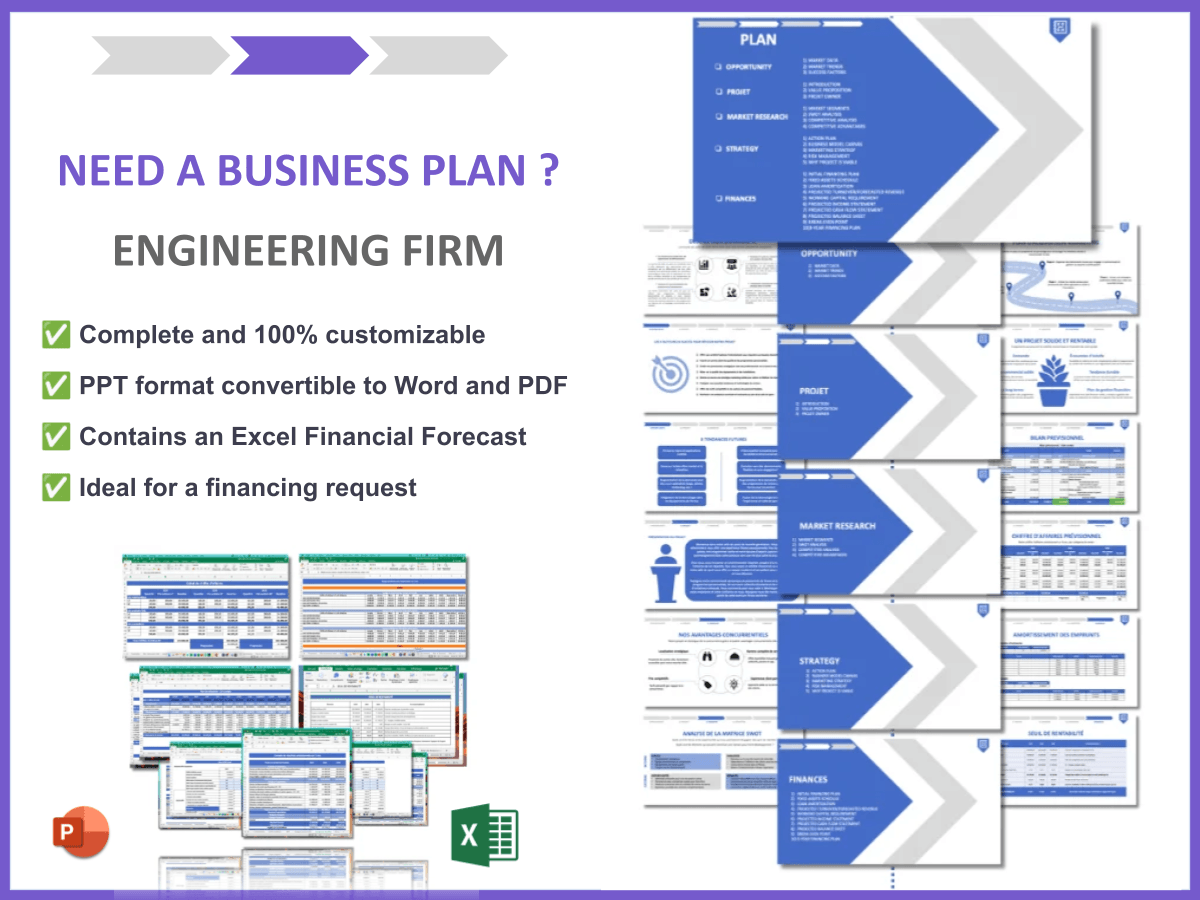Why Should You Have a SWOT Analysis for Your Engineering Firm?
Are you aware that nearly 80% of engineering firms that conduct a SWOT analysis see a marked improvement in their strategic decision-making? This eye-opening fact highlights the critical role a SWOT analysis plays in navigating the competitive landscape. A SWOT analysis, which stands for Strengths, Weaknesses, Opportunities, and Threats, serves as a powerful tool for engineering firms to assess their internal and external environments.
So, why is conducting a SWOT analysis essential for your engineering firm? Here are some compelling reasons:
- Identifies competitive advantages
- Uncovers areas for improvement
- Reveals market opportunities
- Anticipates potential threats
- Guides strategic planning
- Enhances decision-making processes
- Strengthens team collaboration
- Improves risk management
- Aligns resources with goals
- Facilitates communication with stakeholders
How Do You Write a SWOT Analysis for Your Engineering Firm?
Crafting a SWOT analysis involves a systematic approach to evaluate your firm’s position in the industry. Start by gathering your team for a brainstorming session to ensure diverse perspectives are considered. Here’s how to break it down:
Strengths
Identify your firm’s unique capabilities and resources that give you an edge in the market. Consider your team’s expertise, technological advantages, and strong client relationships. Analyze your firm’s reputation and brand value in the engineering community. Evaluate financial stability and access to funding as strengths.
Weaknesses
Recognize areas where your firm may be lacking or underperforming. Assess skills gaps within your team or outdated technology that may hinder progress. Identify any reputational issues or client dissatisfaction affecting your firm. Reflect on resource limitations, including time and budget constraints.
Opportunities
Explore emerging trends in the engineering industry that could benefit your firm. Look for potential partnerships or collaborations that can expand your reach. Analyze market demands for innovative solutions or sustainability practices. Consider geographic expansion or diversification of services.
Threats
Identify external challenges that could impact your firm’s success. Assess competitive pressures and market saturation. Consider regulatory changes that could affect operations. Evaluate economic downturns or industry disruptions that pose risks.
SWOT Example N°1 for Engineering Firm A
This engineering firm effectively utilized its strengths to capitalize on new market opportunities. By conducting a thorough SWOT analysis, they were able to identify their unique advantages and leverage them in a competitive landscape.
| SWOT | Analysis |
|---|---|
| Strengths | Innovative design team, established client base |
| Weaknesses | Limited geographic presence |
| Opportunities | Increasing demand for green building solutions |
| Threats | Rising competition in the local market |
- Innovative team
- Strong client relationships
- Green building opportunities
- Competition challenges
This firm demonstrates how leveraging strengths can lead to new opportunities. By focusing on sustainability, they have positioned themselves as leaders in eco-friendly engineering.
SWOT Example N°2 for Engineering Firm B
Firm B’s analysis revealed critical weaknesses that needed addressing to improve competitiveness. By recognizing these weaknesses, the firm was able to strategize effectively for future growth.
| SWOT | Analysis |
|---|---|
| Strengths | Strong project management |
| Weaknesses | High employee turnover |
| Opportunities | Expanding market in renewable energy |
| Threats | Economic instability |
- Effective project management
- Employee retention issues
- Renewable energy market growth
- Economic challenges
Addressing high turnover can enhance performance and help capitalize on emerging markets. This firm can improve its internal culture to retain talent.
SWOT Example N°3 for Engineering Firm C
Firm C capitalized on its unique strengths to expand its service offerings. By effectively utilizing their SWOT analysis, they identified key areas for growth and improvement.
| SWOT | Analysis |
|---|---|
| Strengths | Diverse service offerings |
| Weaknesses | Inefficient communication |
| Opportunities | Growing infrastructure projects |
| Threats | Increased regulation |
- Diverse service range
- Communication issues
- Infrastructure growth
- Regulatory challenges
By improving communication, Firm C can better coordinate its diverse services and seize infrastructure opportunities more effectively.
SWOT Example N°4 for Engineering Firm D
This firm’s analysis highlighted significant opportunities for growth. Firm D recognized that by leveraging its strengths, it could position itself more competitively in the market.
| SWOT | Analysis |
|---|---|
| Strengths | Strong R&D team |
| Weaknesses | Limited marketing strategy |
| Opportunities | Demand for smart city projects |
| Threats | Competition from larger firms |
- Strong R&D capabilities
- Marketing limitations
- Smart city demand
- Competitive pressure
Investing in marketing can help Firm D leverage its R&D strengths to attract new clients in the smart city sector.
SWOT Example N°5 for Engineering Firm E
Firm E focused on mitigating threats to enhance its market position. By conducting a thorough SWOT analysis, the firm was able to identify potential risks and develop strategies to address them.
| SWOT | Analysis |
|---|---|
| Strengths | Experienced workforce |
| Weaknesses | Slow response to market changes |
| Opportunities | New tech adoption |
| Threats | Rapid technological advancements |
- Experienced staff
- Slow adaptability
- Technology integration
- Rapid tech changes
Firm E needs to enhance its agility in adapting to technological changes to remain competitive.
SWOT Example N°6 for Engineering Firm F
This analysis led Firm F to recognize the value of strategic partnerships. By identifying their strengths and weaknesses, they were able to seek out collaborations that would enhance their capabilities.
| SWOT | Analysis |
|---|---|
| Strengths | Established brand |
| Weaknesses | High operational costs |
| Opportunities | Partnerships with tech firms |
| Threats | Supply chain disruptions |
- Strong brand recognition
- Cost challenges
- Partnership potential
- Supply chain risks
Exploring partnerships can help Firm F mitigate supply chain issues while reducing costs through shared resources.
SWOT Example N°7 for Engineering Firm G
Firm G’s analysis focused on enhancing its service quality. By conducting a detailed SWOT analysis, they identified specific areas where improvements could lead to higher client satisfaction and better overall performance.
| SWOT | Analysis |
|---|---|
| Strengths | High client satisfaction |
| Weaknesses | Limited service range |
| Opportunities | Expanding client base |
| Threats | New entrants in the market |
- Client satisfaction levels
- Service limitations
- Client expansion opportunities
- New competitors
Improving service range can help Firm G attract new clients and fend off competition.
SWOT Example N°8 for Engineering Firm H
Firm H used its SWOT analysis to enhance its project efficiency. By identifying both internal strengths and external threats, they developed strategies to improve their workflow and client delivery.
| SWOT | Analysis |
|---|---|
| Strengths | Skilled engineers |
| Weaknesses | Lack of technology integration |
| Opportunities | Automation in processes |
| Threats | Economic fluctuations |
- Skilled team
- Tech integration issues
- Automation opportunities
- Economic risks
Integrating automation can significantly improve project efficiency for Firm H while mitigating economic risks.
SWOT Example N°9 for Engineering Firm I
This firm’s focus was on sustainability to drive growth. By conducting a comprehensive SWOT analysis, Firm I recognized the importance of aligning its strategies with green initiatives to enhance its market presence.
| SWOT | Analysis |
|---|---|
| Strengths | Sustainability initiatives |
| Weaknesses | Limited market awareness |
| Opportunities | Green technology demand |
| Threats | Regulatory changes |
- Sustainability focus
- Awareness gaps
- Green tech growth
- Regulatory impacts
Firm I should work on increasing market awareness of its sustainability efforts to capitalize on green tech demand.
SWOT Example N°10 for Engineering Firm J
Firm J’s analysis led to innovative project approaches. By conducting a detailed SWOT analysis, they were able to identify both their strengths and potential threats, allowing for strategic adjustments.
| SWOT | Analysis |
|---|---|
| Strengths | Innovative culture |
| Weaknesses | High project costs |
| Opportunities | Collaboration with startups |
| Threats | Changing client expectations |
- Innovative environment
- Cost concerns
- Collaboration potential
- Client expectation shifts
Leveraging collaborations can help Firm J reduce costs while meeting changing client expectations.
Conclusion and Call to Action
Conducting a SWOT analysis is a crucial step for engineering firms seeking to enhance their strategic planning and decision-making. By understanding your strengths, weaknesses, opportunities, and threats, you can better position your firm for success in a competitive landscape. Start your SWOT analysis today and unlock the potential for growth!
For those looking to further solidify their business strategy, check out this business plan template for Engineering Firms. It provides a comprehensive framework to guide your firm’s development.
Additionally, if you’re interested in launching your own engineering firm, be sure to read our article on How to Establish an Engineering Firm?. For insights on promoting your business, check out our guide on How to Build an Engineering Firm Marketing Plan? With Example.
Frequently Asked Questions
What is a SWOT analysis?
A SWOT analysis is a strategic tool used to evaluate the Strengths, Weaknesses, Opportunities, and Threats of a business or project.
Why is a SWOT analysis important for engineering firms?
This analysis helps engineering firms assess their market position and make informed strategic decisions.
How often should an engineering firm conduct a SWOT analysis?
It is beneficial to perform a SWOT analysis annually or whenever significant changes occur within the firm or industry.
What should be included in a SWOT analysis?
A comprehensive SWOT analysis should encompass an evaluation of internal strengths and weaknesses, along with external opportunities and threats.
Can a SWOT analysis help with project planning?
Yes, it provides insights that inform project objectives and resource allocation.
Who should be involved in creating a SWOT analysis?
Involving a diverse team can yield a well-rounded perspective on the firm’s position.
How can weaknesses be turned into strengths?
By addressing and improving areas of weakness, firms can enhance their overall capabilities.
What are some common threats for engineering firms?
Common threats include competition, regulatory changes, and economic fluctuations.
How does a SWOT analysis influence strategic decisions?
It provides a clear understanding of the firm’s environment, guiding decision-making processes.
Is there a specific format for a SWOT analysis?
While there’s no strict format, a simple four-quadrant table is commonly used for clarity.







